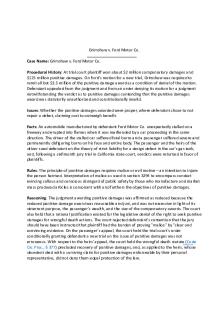Cambridge Water CO v Eastern Countries Leather - Case summary PDF

| Title | Cambridge Water CO v Eastern Countries Leather - Case summary |
|---|---|
| Course | Introduction to Case Law |
| Institution | Victoria University of Wellington |
| Pages | 2 |
| File Size | 65.3 KB |
| File Type | |
| Total Downloads | 99 |
| Total Views | 161 |
Summary
Case summary...
Description
CAMBRIDGE WATER CO v EASTERN COUNTRIES LEATHER [1994] – Lord Gof Material Facts The defendant used a chemical in their business When spilled on the ground, over time the chemical found its way into a borehole, contaminating the water It was not foreseeable that the chemical would act in this way. A reasonable person would not have foreseen either that the spill would result in environmental harm or that PCE would result in the level of contamination of the water Ratio
A defendant will not be liable for damages under the rule in Rylands v Fletcher unless the damage is reasonably foreseeable while the activity or substance is under his or her control.
Issue Is a defendant liable under the rule in R v F for contamination of a plaintiff's water supply by leakage of chemicals from its factory through the ground waters system even if the damage is not foreseeable? Procedural History Key reasoning in this: foreseeability All judges in agreement- quite a persuasive judgment Foreseeability of the harm is a pre-requisite of Rylands v Fletcher liability R v F and nuisance are extremely similar and foreseeability is required under nuisance Blackburn J’s language evokes ideas of foreseeability of the risk of harm Blackburn J spoke of anything "likely to do mischief if it escapes", and later he spoke of something "which he knows to be mischievous if it gets on his neighbour's property" and the liability to "answer for the natural and anticipated consequences” [306] No cases establish definitively that foreseeability is NOT required. We do not want to extend the applicability of RvF to ultra hazardous activities. It makes sense that nuisance and RvF have the same requirements. Lord Goff concludes that R v F is "an extension of the law of nuisance to cases of isolated escapes from land" and therefore foreseeability of harm is a requirement for liability under R v F [306] "One important submission advanced by ECL before the Appellate Committee was that strict liability for an escape only arises under that rule where the defendant knows or reasonably ought to have foreseen, when collecting the relevant things on his land, that those things might, if they escaped, cause damage of the relevant kind” [297] House of Lords Reasoning Should liability be imposed because the PCE is still leaking into the water supply and the defendants are now aware of the harm? ECL is no longer causing the escape of PCE so it is beyond their control At the time they were using it, it was not foreseeable. The fact it is foreseeable now is irrelevant because they are no longer doing it Clearly the judge is saying it needs to be foreseeable at the time you are using it The use of chemicals by the tannery is a non-natural use of land (obiter) Obiter because his key conclusion was based on foreseeability: "In view of my conclusion on the issues of foreseeability, I can deal with this point shortly" A lack of precision in the concept of ‘ordinary use’.
‘Use as is proper for the general benefit of the community’ could be applied to the provision of services (ie utilities) but not the wider interests of the local community or creation of employment. [308/309] Need to keep the exception within reasonable bounds – if it is allowed to be too broad, will lose its meaning. Just because something is common within the industry, this does not mean it is ‘ordinary’ or ‘natural’ use. The storage of substantial quantities of chemicals on industrial premises should be regarded as a classic case of non-natural use, therefore the argument of “general benefit of the community” is not sufficient....
Similar Free PDFs

Summary - Eastern Philosophy
- 17 Pages

Eastern Greenland Case (1933)
- 2 Pages

Parker v South Eastern Railway
- 1 Pages

Zoa leather
- 33 Pages

Snyder V. Phelps Case Summary
- 2 Pages

UK v Norway case summary
- 3 Pages
Popular Institutions
- Tinajero National High School - Annex
- Politeknik Caltex Riau
- Yokohama City University
- SGT University
- University of Al-Qadisiyah
- Divine Word College of Vigan
- Techniek College Rotterdam
- Universidade de Santiago
- Universiti Teknologi MARA Cawangan Johor Kampus Pasir Gudang
- Poltekkes Kemenkes Yogyakarta
- Baguio City National High School
- Colegio san marcos
- preparatoria uno
- Centro de Bachillerato Tecnológico Industrial y de Servicios No. 107
- Dalian Maritime University
- Quang Trung Secondary School
- Colegio Tecnológico en Informática
- Corporación Regional de Educación Superior
- Grupo CEDVA
- Dar Al Uloom University
- Centro de Estudios Preuniversitarios de la Universidad Nacional de Ingeniería
- 上智大学
- Aakash International School, Nuna Majara
- San Felipe Neri Catholic School
- Kang Chiao International School - New Taipei City
- Misamis Occidental National High School
- Institución Educativa Escuela Normal Juan Ladrilleros
- Kolehiyo ng Pantukan
- Batanes State College
- Instituto Continental
- Sekolah Menengah Kejuruan Kesehatan Kaltara (Tarakan)
- Colegio de La Inmaculada Concepcion - Cebu









